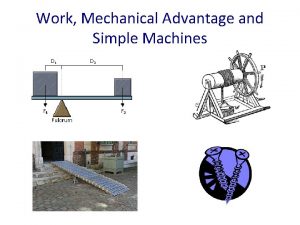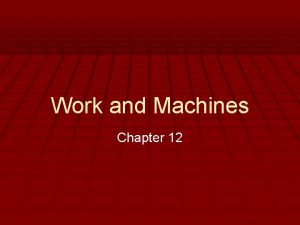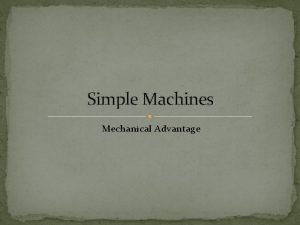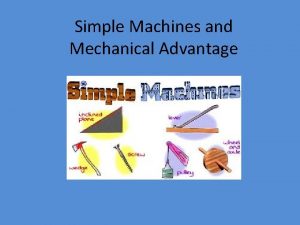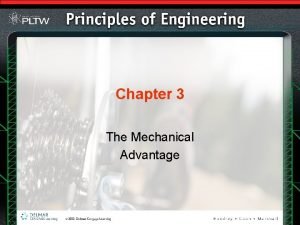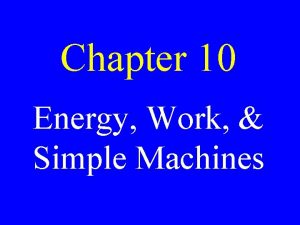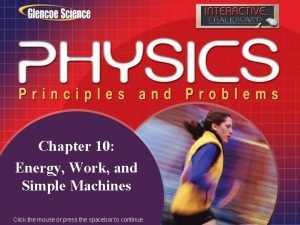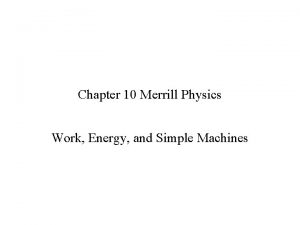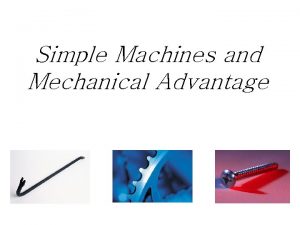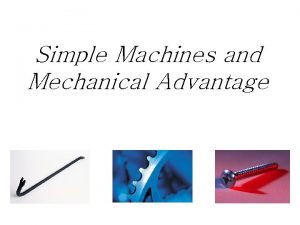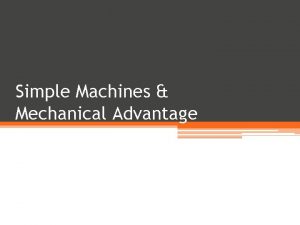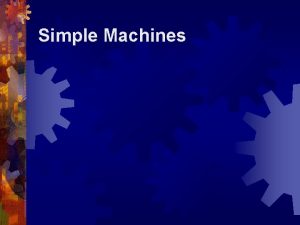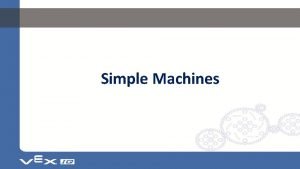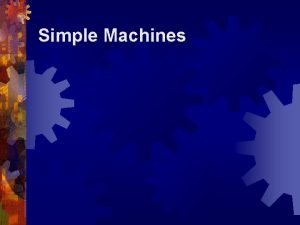Work Mechanical Advantage and Simple Machines Work The











- Slides: 11

Work, Mechanical Advantage and Simple Machines

Work The work done by a constant force of magnitude F on a point that moves a displacement d in the direction of the force is the product, W = Fd where W is work, F is force and d is distance. Unit of work is the newton-meter or Joule 1 Nm = 1 joule

Example If a force of 10 newtons (F = 10 N) acts on a point that travels 2 meters (d = 2 m), then it does the work W = (10 N)(2 m) = 20 Nm = 20 J. This is approximately the work done lifting a 1 kg weight from the ground to over a person's head against the force of gravity.

Mechanical Advantage In physics and engineering, mechanical advantage (MA) is the factor by which a machine multiplies the force put into it. It trades off forces against movement to obtain a desired amplification in the output force over the input force.

Inclined Plane (Ramp) Mechanical Advantage (MA) MA = Length/Rise Wout = Win Wout = Fg x Rise Win = Fi x Length MA = Fg/Fi = Length/Rise Fi = Fg x Rise/Length Example: For Rise = 1 and Length = 2 MA = 2 Fi = ½ F g

Screw Inclined plane where flights are on an angle forming a continuous ramp around the central shaft. This makes the screw easier to turn against a given resistance.

Lever F 1 x D 1 = F 2 x D 2 In physics, a lever is a rigid object that is used with an appropriate fulcrum or pivot point to multiply the mechanical force that can be applied to another object. MA = length of effort arm ÷ length of resistance arm = D 2 ÷ D 1

Wheel and Axle Wheel Axle Lever with D 2 = radius of wheel and D 1 = radius of axel

Energy is the capacity of a system to do work. The unit of energy is the joule or newton-meter (same as work). Remember work = force x distance

Example If a person pushes an object x meters against an opposing force of F newtons, Fx joules (newton-meters) of work has been done on the object. The person's body has lost Fx joules of energy and the object has gained Fx joules of energy.

Example If a force of 10 newtons (F = 10 N) acts on a point that travels 2 meters (d = 2 m), then it does the work W = (10 N)(2 m) = 20 Nm = 20 J. This is approximately the work done lifting a 1 kg weight from the ground to over a person's head against the force of gravity. F = ma = 1 kg x 10 m/s 2 = 10 N The person’s body has lost 20 J of energy and the weight has gained 20 J of (potential) energy.
 Actual mechanical advantage vs ideal mechanical advantage
Actual mechanical advantage vs ideal mechanical advantage Section 4 review physical science
Section 4 review physical science Mechanical machine
Mechanical machine How does mechanical advantage work
How does mechanical advantage work The ratio of resistance force to effort force
The ratio of resistance force to effort force Wheel and axle mechanical advantage
Wheel and axle mechanical advantage Ideal mechanical advantage definition
Ideal mechanical advantage definition Chapter 10 energy work and simple machines answer key
Chapter 10 energy work and simple machines answer key Chapter 10 energy, work and simple machines answer key
Chapter 10 energy, work and simple machines answer key Energy work and simple machines chapter 10 answers
Energy work and simple machines chapter 10 answers Chapter 10 energy work and simple machines answer key
Chapter 10 energy work and simple machines answer key Mechanical drives and lifting machines n2
Mechanical drives and lifting machines n2


